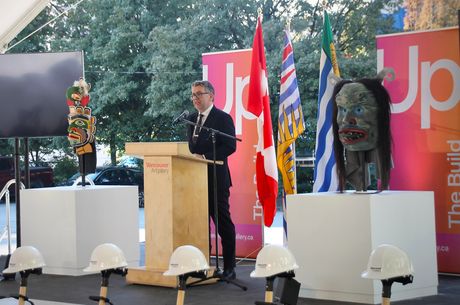
A “ground awakening ceremony” for the Vancouver Art Gallery’s (VAG) long-awaited new building on Friday (15 September) began auspiciously, with the announcement of a C$5m ($3.7m) donation from the Djavad Mowafaghian Foundation. The capital campaign for the new gallery, designed by Herzog & de Meuron and scheduled for completion in 2028, is now only C$55m ($40.7m) short of its C$400m ($295.7m) fundraising goal.
Although the initiative for the new gallery began in 2004 under the leadership of then-director Kathleen Bartels, current director Anthony Kiendl tells The Art Newspaper that the 19-year journey is not unusual for an institution that works on a “collaborative model” with local communities. “Look at [the Los Angeles County Museum of Art] or M+ in Hong Kong,” he says, “they’ve both taken over 15 years.”
There was a sense of both relief and celebration at the ceremony, where civic, provincial and federal politicians rubbed shoulders with First Nations dancers and art world cognoscenti, marking a significant milestone on what has been a long and winding road.
After the VAG’s 2004 master planning process determined that the gallery needed more exhibition and storage space for its collection—which includes one of the world’s most significant collections of works by Emily Carr—the museum sought the approval of Vancouver’s city council to build a new gallery. The chosen site at Larwill Park—currently a parking lot—is seven blocks east of the neo-classical Edwardian-era former courthouse designed by Francis Rattenbury in 1913 and renovated by Arthur Erickson in 1983 (as part of his three-block Robson Square project) when the VAG moved in after relocating from an earlier location. In 2008, the city council—which will continue to lease land to the VAG as per current arrangements—changed the site to the Plaza of Nations before reversing its decision in 2013.
In 2014, the VAG selected Herzog & de Meuron as the project’s architecture firm (with Vancouver’s Perkins and Will as the executive architects) and the Swiss firm’s design has changed considerably since then. Its current incarnation features a woven copper facade in homage to traditional Musqueam (the First Nation of the area) weaving techniques—conceived in consultation with Native artists—as well as expanded outdoor space.
Originally destined for completion in 2020, there was speculation that the project would never see the light of day due to lack of funding and other challenges. But the fundraising campaign was reinvigorated in 2019 by a gift of C$40m ($29.6m) from the philanthropic Chan family; as a result, the new building will be named the Chan Centre for the Visual Arts. At the time, it was the largest private donation to arts and culture in British Columbia, but was surpassed by a donation of C$100m ($73.9m) from the Audain Foundation in 2021—the largest cash donation to a Canadian public art museum to date.
With site remediation and construction on the new building to begin this autumn, the VAG has launched a final fundraising effort dubbed “The Build Up”. Focusing on big moves like dedicated space for the Institute of Asian Art, a multi-purpose Indigenous Community House, a state-of-the-art theatre, public outdoor spaces, dedicated artist
studios and a doubling of exhibition space to 80,000 sq. ft, the campaign hopes to raise the remaining $55m from a combination of private, corporate and government funding.
Adding to the sense of momentum are the VAG’s new hires: Eva Respini, who will lead the curatorial vision for the new gallery, and Sirish Rao, the new director of public engagement and learning.
At Friday’s ceremony, champions of the new VAG building promised C$88.2m ($65.2m) in new tourism revenue and a “modern cultural hub” in the heart of Vancouver, next to the Vancouver Public Library and the Queen Elizabeth Theatre, bordering Vancouver’s historic Chinatown and Gastown neighbourhoods.
True to the area’s original Musqueam function as a meeting site, Kiendl says, the new building also promises to be a cultural crossroads for diverse artists and an example of “reconciliation in action”. A moving ceremony by the family of the late Beau Dick, the Kwakwaka’wakw Northwest Coast artist and Chief, marked the VAG’s acquisition of 17 masks from his Undersea Kingdom series. The masks were prepared for Documenta shortly before Dick’s untimely death in 2017 and the acquisition by the VAG—which began building a significant collection of traditional and contemporary First Nations art in the 1980s—bodes well for the new building.
The future building’s weaving-inspired façade, Kiendl adds, “embodies a Coast Salish worldview, creating a blanket or veil that will protect the building and its inhabitants and collections”.
